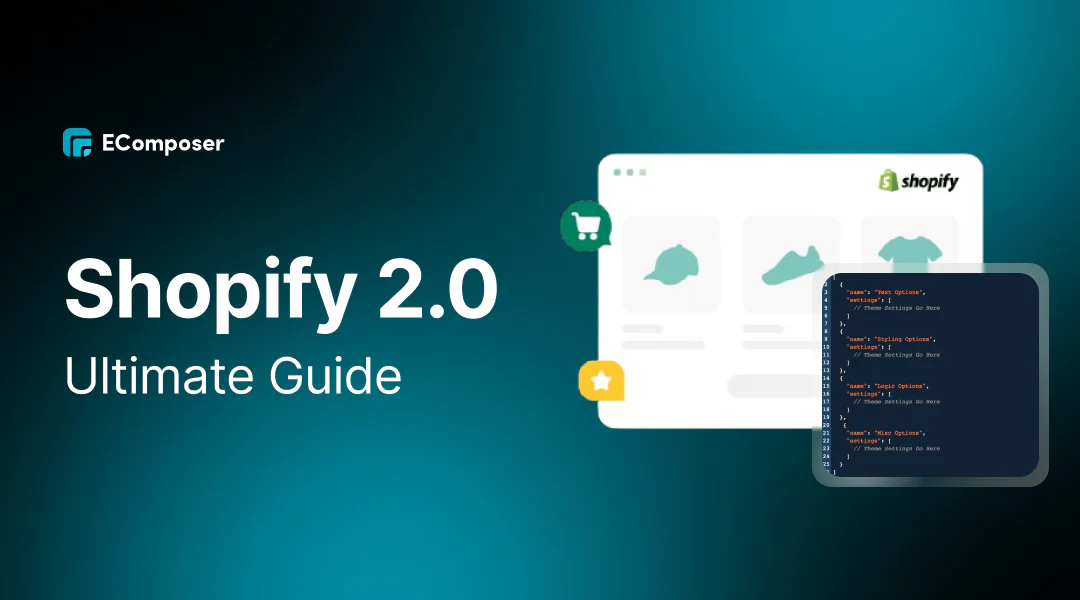Shopify 2.0 introduces a variety of new features that enhance the flexibility and customization of Shopify themes, enabling e-commerce businesses to create unique, high-performance online stores. In 2024, understanding the benefits and best practices for Shopify 2.0 theme development is crucial for optimizing user experience and increasing conversions. This guide provides insights into Shopify 2.0’s new capabilities and how to leverage them effectively.
Understanding Shopify 2.0: Key Features
Improved
Customization with Sections Everywhere
A standout feature of Shopify 2.0 is the ability to add "Sections
Everywhere." This expands the use of sections beyond the homepage,
allowing them to be used across various pages such as product and collection
pages. This flexibility enables store owners to create dynamic, personalized
layouts for different types of content, improving overall site usability and
design control.
Enhanced
Theme Architecture
Shopify 2.0’s new architecture, which incorporates JSON templates, streamlines
theme development by allowing developers to create reusable components. This
reduces redundancy and improves code efficiency. It also makes it easier to
manage and update themes, especially for stores with more complex structures or
frequent changes in content. Click here
Benefits of Shopify 2.0 Themes
Design
Flexibility
Shopify 2.0 themes offer unparalleled design flexibility. The ability to easily
add, remove, and rearrange sections using a drag-and-drop interface gives store
owners creative freedom without needing to know how to code. This feature makes
it easier for businesses to align their store design with branding goals or
seasonal campaigns.
Improved
Store Management
The new theme management tools in Shopify 2.0 allow store owners to control
design elements such as colors, fonts, and layouts directly through the admin
panel. The ability to manage sections across all pages, not just the homepage,
streamlines the customization process and provides a more cohesive store
management experience.
Best Practices for Shopify 2.0 Theme Development
Maximizing
Sections Everywhere
One of the most valuable features of Shopify 2.0 is Sections Everywhere, which
allows developers to design pages with a variety of dynamic content blocks.
This ensures that each page can be tailored to specific needs, such as
showcasing featured products, promotional banners, or customer reviews. By
leveraging sections, developers can create a personalized, engaging shopping
experience for users, which ultimately improves conversion rates. Click here
Optimizing
Performance for Speed
Store speed is critical to user satisfaction and SEO rankings. Shopify 2.0
themes require optimization for fast load times. To achieve this, developers
should compress images, use lazy loading techniques, and minimize JavaScript
and CSS files. Shopify’s built-in CDN (Content Delivery Network) automatically
optimizes images for faster loading across different devices. This performance
optimization ensures a seamless browsing experience for customers, which is key
to reducing bounce rates.
Ensuring
Accessibility
With accessibility becoming more important in e-commerce, Shopify 2.0 themes
must comply with best practices for inclusive design. Themes should feature
high color contrast for readability, provide alt text for images, and implement
proper heading structures for screen readers. Developers should also ensure
that navigation is fully functional with keyboard shortcuts and that forms are
accessible to all users. These measures help improve the customer experience
for users with disabilities and ensure that the site adheres to legal
accessibility standards.
Mobile Optimization for User Experience
Mobile-First
Design Principles
As mobile commerce continues to grow, optimizing Shopify 2.0 themes for mobile
is non-negotiable. Shopify 2.0 themes are designed with mobile-first
principles, meaning that the design is responsive and adapts to different
screen sizes. Developers should test mobile designs for touch-friendly
navigation and ensure that important actions like adding items to the cart or
completing the checkout process are easy to execute on smaller screens. Click here
Streamlining
Mobile Checkout
A seamless mobile checkout process is crucial to reducing cart abandonment on
mobile devices. Shopify 2.0 allows developers to customize checkout pages to
match the store’s branding, but it’s essential to simplify the process. Store
owners should minimize form fields, enable quick payment options (like Apple
Pay or Google Pay), and ensure that the mobile checkout experience is as
user-friendly as possible to improve conversions.
Third-Party Integrations and SEO
Utilizing
Apps to Enhance Functionality
Shopify 2.0 supports easy integration with third-party apps that add valuable
functionality to the store. Whether it’s for email marketing, live chat, or
customer loyalty programs, these apps can enhance the shopping experience.
Shopify’s API and app integration capabilities allow developers to build custom
solutions that fit the unique needs of each business.
SEO
Optimization
SEO is vital for driving traffic to your Shopify store. Shopify 2.0 themes come
with enhanced SEO features such as customizable meta tags and URL structures.
Developers can also optimize image alt text and heading tags, both of which
help improve visibility on search engines. Additionally, integrating SEO tools
and monitoring analytics can guide store owners on where to improve and how to
target the right audience.
Testing and Debugging Your Theme
Cross-Browser
and Device Testing
Once the theme is built, it’s crucial to test it across multiple browsers and
devices. Shopify provides tools like the Theme Inspector to help identify
performance issues and debug problems. Ensuring that your theme works
seamlessly across different environments is essential to providing a consistent
experience for all users, regardless of the device or browser they are using. Click here
A/B
Testing for Optimization
A/B testing is an effective way to optimize Shopify 2.0 themes. Developers can
test different layouts, images, or call-to-action placements to see which
elements drive higher engagement or conversion rates. By using A/B testing
tools integrated with Shopify, store owners can make data-driven decisions to
improve user experience and sales.


